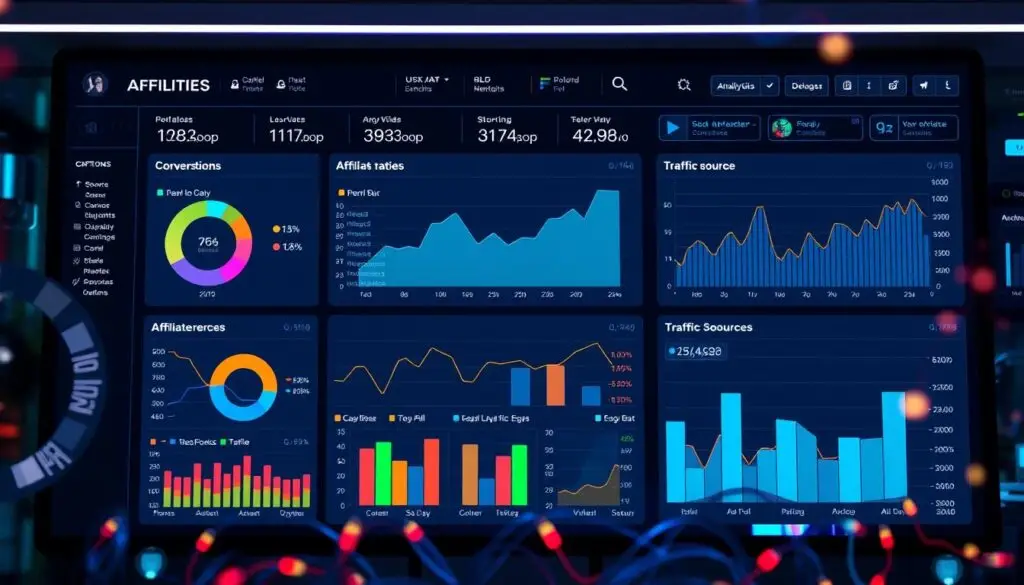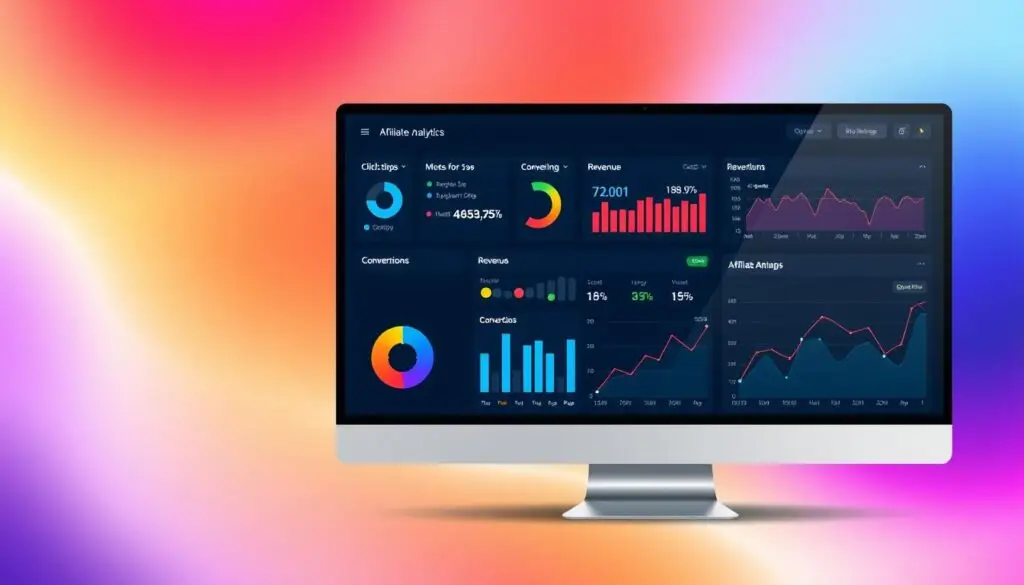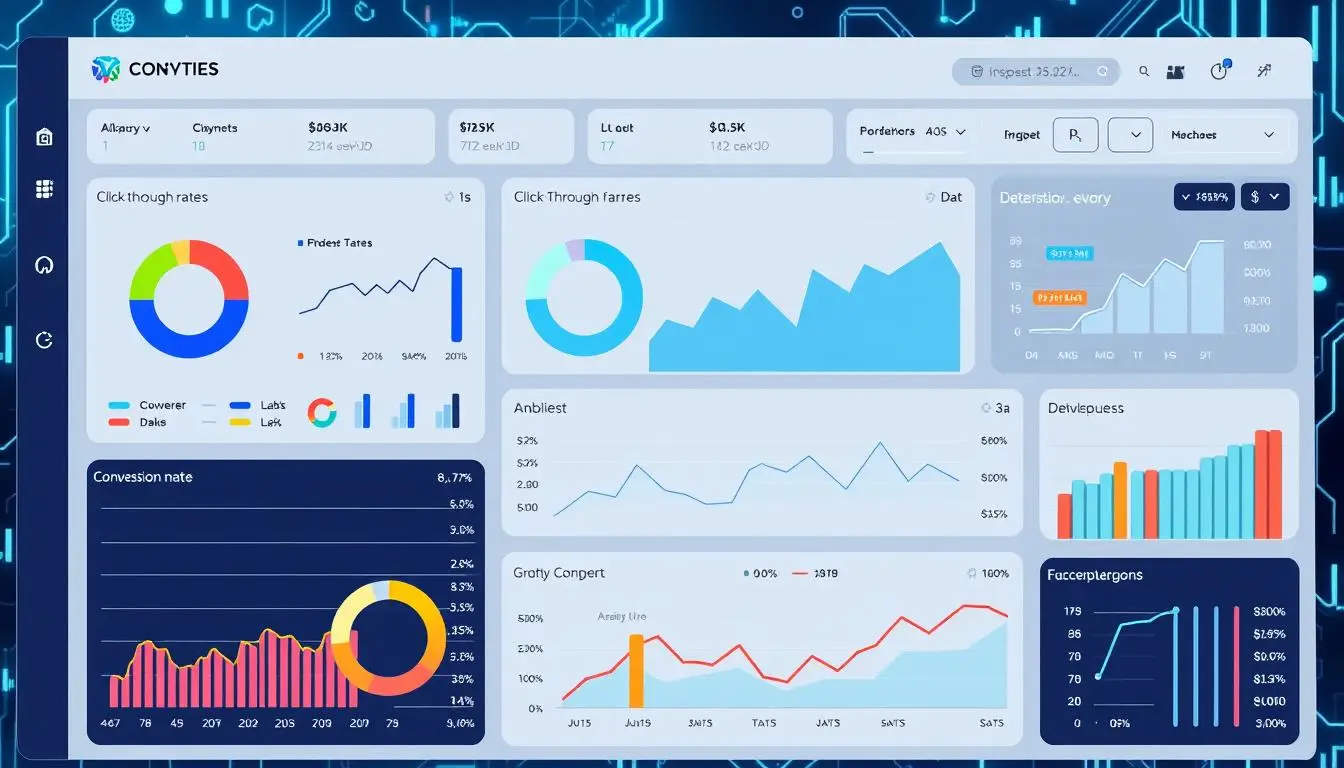|
Getting your Trinity Audio player ready...
|
Ever felt lost in a sea of numbers trying to understand your affiliate marketing? I have. The endless spreadsheets and confusing metrics can be overwhelming. But, mastering affiliate marketing analytics is key to your success.
Imagine turning confusing figures into a clear roadmap for your business growth. That’s what mastering affiliate marketing analytics can do. It turns raw data into insights that boost your profits.
This guide is your compass in the world of affiliate marketing reporting. We’ll explore essential metrics, decode data insights, and find strategies to boost your affiliate program’s performance. Get ready to make decisions based on data that will change your campaigns and increase your revenue.
Ready to unlock the full potential of your affiliate marketing efforts? Let’s dive in and turn those numbers into your greatest asset.
The Importance of Analytics in Affiliate Marketing
Analytics are key to success in affiliate marketing. They help you make smart choices, track how well you’re doing, and find new ways to grow. Let’s see how analytics can boost your affiliate partnerships ROI and help you reach your goals.
Driving Data-Informed Decisions
Analytics give you insights into your audience’s likes and actions. By using this data, you can make your marketing more appealing to your audience. This way, you can make your campaigns better and improve your program’s KPIs.

Measuring Campaign Performance
Tracking important metrics lets you see how well your marketing is doing. You can look at things like conversion rates and average order value. This helps you know which campaigns are bringing in the most money. You can then focus on the best affiliates and use your resources wisely.
Identifying Growth Opportunities
Analytics show you trends and patterns in your data. By looking at these, you can find new chances to grow. This could mean entering new markets, working with different affiliates, or changing your commission structure. Regularly checking your ROI helps you make choices that grow your program.
Key Affiliate Marketing Metrics to Track
![]()
Tracking the right metrics is key to your affiliate marketing success. By watching key performance indicators, you can make your campaigns better and increase your earnings. Let’s look at some important affiliate tracking metrics you should watch.
Click-through rate (CTR) shows how often people click on your affiliate links. A high CTR means your content connects well with your audience. To get better affiliate link performance, make your calls-to-action compelling and place links wisely in your content.
Conversion rate shows how many visitors do what you want them to, like buying something. To get more conversions, make sure your landing pages are good and match the offers you’re promoting. Try different page designs and messages to see what works best for your audience.
Average order value (AOV) is the average amount spent per transaction. To increase your AOV, promote more expensive products or suggest related items to customers.
- Click-through rate (CTR)
- Conversion rate
- Average order value (AOV)
- Customer lifetime value (CLV)
Customer lifetime value (CLV) is a long-term metric that shows the total revenue a customer will bring over time. Focus on promoting products with high CLV to increase your earnings.
By regularly checking these affiliate tracking metrics, you’ll get important insights into how your campaigns are doing. Use this data to tweak your strategies and grow your affiliate marketing business.
Understanding And Using Affiliate Marketing Analytics
Affiliate marketing reporting is key to success. It helps you make smart choices and improve your results. Let’s look at how to understand insights, apply analytics, and use the right tools.
Interpreting Data Insights
To get the most from your affiliate program KPIs, focus on trends and patterns. Look at conversion rates, click-through rates, and average order value. These metrics show which affiliates are most valuable and where you can improve.

Applying Analytics to Strategy
Use your findings to improve your affiliate marketing strategy. If some products do well, promote them more. Find your top-performing affiliates and work with them more. Adjust commission structures to motivate better results.
Tools for Effective Analysis
Use powerful tools to make your affiliate marketing reporting easier. Popular choices include:
- Google Analytics for tracking website traffic
- Dedicated affiliate platforms like ShareASale or Commission Junction
- Custom dashboards to visualize your affiliate program KPIs
These tools help you collect, analyze, and act on data quickly. This leads to ongoing improvement in your affiliate marketing.
Affiliate Tracking Metrics: Beyond the Basics
![]()
Exploring affiliate tracking metrics can reveal important insights for your marketing strategy. Advanced analytics give you a detailed look at how your program is doing. This helps you find ways to get better.
It’s important to look at where your traffic comes from. Knowing this helps you use your resources wisely and improve your marketing. Some key places to watch include:
- Social media platforms
- Email campaigns
- Organic search results
- Paid advertisements
To really understand your affiliate marketing program, track customer journey touchpoints. This means following each step a potential customer takes before buying. It shows you which steps are most important for sales.
Also, consider multi-channel attribution. This method shows how different marketing channels work together to make a sale. It helps you see how each channel contributes, guiding your decisions on where to focus.
Success comes from always analyzing and adjusting based on these metrics. Stay curious and keep trying new things to grow your affiliate marketing.
Mastering Affiliate Program KPIs
Successful affiliate marketing needs the right metrics. Learning about affiliate program KPIs helps you track progress and make smart choices. Let’s look at how to set, align, and boost your key performance indicators.
Setting Meaningful KPIs
Pick KPIs that really show how your program is doing. Look at conversion rate, average order value, and customer lifetime value. These metrics give you a clear view of your affiliate marketing success.
Aligning KPIs with Business Goals
Your affiliate program KPIs should help reach your business goals. If you want to grow your market share, track new customer acquisition. For profit, watch revenue per click. This makes sure your affiliate work helps the company succeed.
Regularly Reviewing and Adjusting KPIs
Affiliate marketing reporting is ongoing. Check your KPIs every month or quarter to keep them current. As your program grows, be ready to change your metrics. This keeps you in tune with market shifts and program growth.
- Analyze trends in your data
- Identify underperforming areas
- Celebrate and replicate successes
By mastering these KPI aspects, you’ll build a data-driven strategy. This will push your affiliate marketing forward. Remember, the right metrics lead to smart decisions and ongoing improvement in your program.
Affiliate Commission Analysis: Maximizing Earnings
Looking into affiliate commission analysis is key to making more money. By checking out commission structures, you can make rates better for everyone. This is important for boosting the return on investment in your affiliate partnerships.
First, check your current commission rates. Are they good compared to others in your field? Do they get affiliates excited to sell your stuff? Think about setting up a tiered system to thank your best partners. This can lead to more sales and keep your affiliates happy.
To earn more, look at these things:
- Product pricing and profit margins
- Average order value
- Affiliate performance metrics
- Conversion rates
- Customer lifetime value
Use what you learn to change your commission rates wisely. Give more for products with high profit margins to get affiliates to sell those more. You could also give bonuses for hitting sales goals or bringing in new customers.
Doing regular checks on affiliate commissions keeps you ahead and keeps partnerships profitable. By tweaking your commission setup, you can help your business grow and reward your top affiliates.
Affiliate Conversion Optimization Techniques
Boosting your affiliate conversion is crucial for earning more. By refining your strategies, you can greatly enhance your affiliate link performance. This leads to more sales.
Improving Landing Page Performance
Your landing page is the first thing potential customers see. Make it memorable with a clean, easy-to-use design. Use catchy headlines, clear product benefits, and high-quality images to draw attention.
Don’t forget to optimize for mobile users. A responsive design is essential for mobile conversions.
Optimizing Call-to-Action Strategies
Your call-to-action (CTA) is vital for your affiliate link success. Use words like “Buy Now” or “Get Your Discount” to create urgency. Place your CTAs where they’re easy to see and make them stand out with contrasting colors.
A/B Testing for Higher Conversions
A/B testing is a key tool for improving your affiliate conversion. Test different parts of your landing page, like headlines, images, or CTA buttons. Compare the results to find out which version works best.
This data-driven method helps you refine your strategies. It boosts your conversions over time.
- Test different color schemes
- Experiment with various CTA placements
- Try different product descriptions
Remember, affiliate conversion optimization is a continuous process. Keep testing, analyzing, and refining your approach. This will lead to consistent improvements in your affiliate link performance.
Analyzing Affiliate Traffic Sources for Better ROI
Understanding your affiliate traffic sources is key to better ROI. By looking closely at your traffic data, you can make smart choices. This helps you know where to put your efforts and resources.
- Social media platforms
- Content marketing channels
- Paid advertising campaigns
- Email marketing
- Organic search results
After identifying your sources, examine their performance. Look at click-through rates, conversion rates, and average order value for each. This will show you which sources bring in the most valuable customers.
Also, think about the quality of traffic from each source. Some channels might have lots of visitors but few sales. Others might have fewer visitors but more sales. Finding the right balance between quantity and quality is essential for better ROI.
Use this information to improve your strategy. Spend more on channels that work well and rethink your approach for those that don’t. By always improving your tactics based on data, you’ll increase your affiliate marketing success.
Affiliate Link Performance: Tracking and Improving
Tracking and improving affiliate link performance is key to success in affiliate marketing. By focusing on affiliate tracking metrics, you can increase your earnings and make your campaigns better. Let’s look at some effective ways to boost your affiliate link performance.
First, create compelling affiliate links. Use clear, concise anchor text that encourages clicks. Avoid generic phrases like “click here” and choose descriptive text that shows value. For instance, “Get 20% off premium skincare products” is better than “Buy now”.
Keep an eye on your affiliate link performance across various channels. Use unique tracking links for each platform to see which ones bring in the most traffic and sales. This information helps you focus on the most profitable channels.
- Social media posts
- Blog articles
- Email newsletters
- YouTube video descriptions
Try A/B testing to boost click-through rates. Make different versions of your affiliate links and compare them. Test different call-to-action phrases, button colors, or link placements to see what works best with your audience.
Regularly check your affiliate tracking metrics to spot trends and opportunities. Look for patterns in conversion rates, average order value, and commission earnings. Use these insights to improve your strategies and focus on top-performing products or offers.
Think about using link cloaking tools to make shorter, more appealing URLs. This can boost trust and click-through rates, especially on platforms like Twitter with character limits. Learning to master affiliate marketing analytics is crucial for overcoming common challenges and achieving success.
Advanced Analytics for Affiliate Marketing Success
Understanding and using affiliate marketing analytics is key to success. With cutting-edge techniques, you can uncover deeper insights. This drives long-term success in your affiliate marketing efforts.
Predictive analytics helps forecast future trends and outcomes. By looking at past data, you can guess which products or promotions will do well. This lets you make smart strategy changes and use resources wisely.
Machine learning is changing affiliate marketing reporting. These tools find patterns and anomalies in big datasets. They reveal insights that might be missed otherwise. For example, they can find the best affiliate partners, content types, and channels.
Data visualization is also a strong tool for understanding and using affiliate marketing analytics. It makes complex data easy to see in charts and graphs. This helps you quickly spot trends and make good decisions. It’s great for sharing results with stakeholders or team members.
To use these advanced analytics techniques:
- Invest in strong analytics platforms with predictive modeling
- Look into machine learning tools for affiliate marketing
- Use interactive dashboards for live data visualization
- Keep improving your affiliate marketing reporting
By using these advanced analytics, you’ll get ahead in the fast-changing world of affiliate marketing.
Conclusion
Mastering affiliate marketing analytics is key to your success. It lets you make smart choices that boost your campaigns. You’ll know what’s working and what to tweak.
It’s important to set and track the right KPIs for your affiliate program. These metrics guide you towards better results and more earnings. By analyzing your data, you can find trends, grab opportunities, and stay competitive.
In the fast-changing world of affiliate marketing, being adaptable is crucial. Use data to make better decisions and keep improving your strategies. With focus and a sharp eye on your analytics, you’ll overcome challenges and enjoy the rewards of affiliate marketing.

